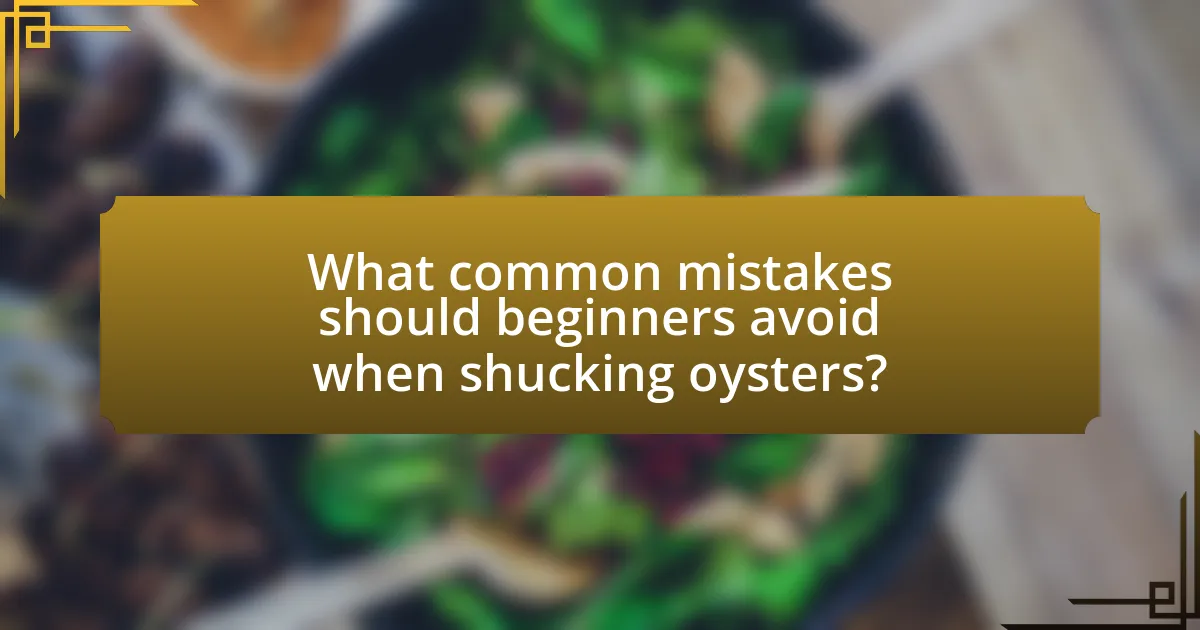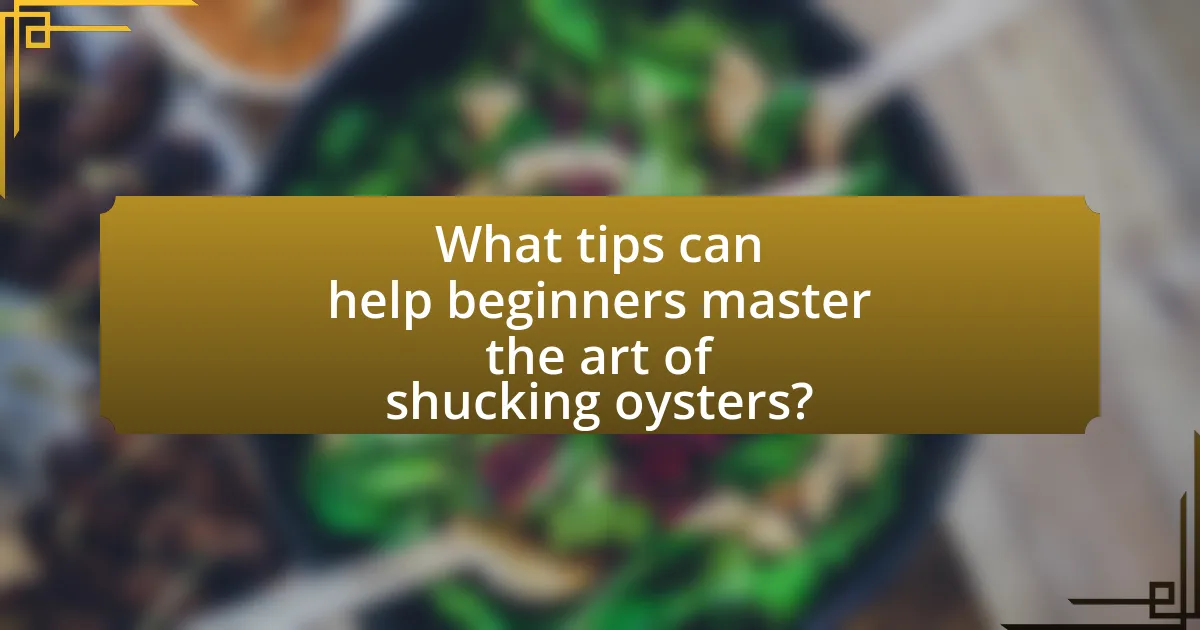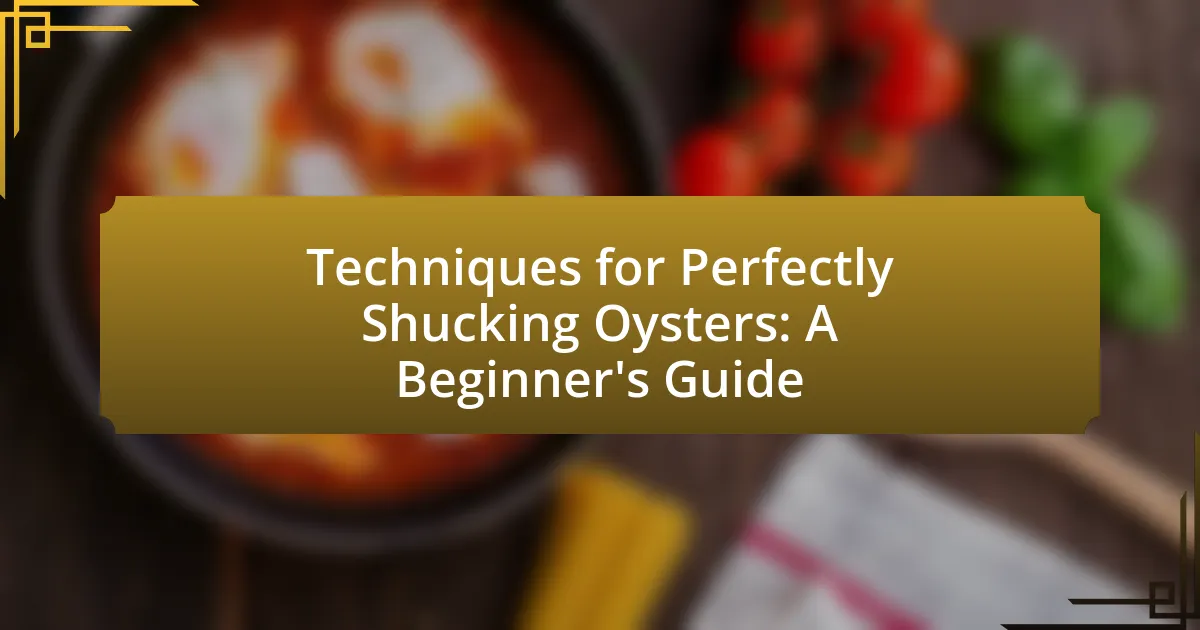The article focuses on essential techniques for shucking oysters, providing a comprehensive guide for beginners. It covers the necessary tools, including the types of oyster knives and the importance of protective gloves, as well as detailed steps for the shucking process. Safety precautions, common mistakes to avoid, and best practices for cleaning and storing oysters are also discussed. Additionally, the article offers expert recommendations for serving and enhancing the flavor of shucked oysters, ensuring a safe and enjoyable experience for those new to this culinary skill.

What are the essential techniques for shucking oysters?
The essential techniques for shucking oysters include using a proper oyster knife, applying pressure to the hinge, and carefully prying open the shell. First, select a sturdy oyster knife with a short, blunt blade designed for shucking. Next, hold the oyster with the cupped side down and the hinge facing you, using a towel or glove for grip and protection. Insert the knife into the hinge and apply gentle pressure until it pops open. Once the shell is open, slide the knife along the top shell to detach the muscle, ensuring the oyster remains intact in the bottom shell. This method is validated by culinary experts who emphasize the importance of safety and technique to avoid injury and ensure the oyster’s quality.
How do you choose the right tools for shucking oysters?
To choose the right tools for shucking oysters, select a high-quality oyster knife designed specifically for the task. An oyster knife typically features a short, sturdy blade with a pointed tip to easily pry open the shell without damaging the meat inside. Additionally, consider using a protective glove or towel to grip the oyster securely and prevent slips during the shucking process. The effectiveness of these tools is supported by the fact that specialized oyster knives reduce the risk of injury and improve efficiency, as they are engineered to handle the unique challenges posed by oyster shells.
What types of oyster knives are available and how do they differ?
There are several types of oyster knives available, including standard, curved, and hinged knives, each differing in blade shape and intended use. Standard oyster knives feature a flat, wide blade that is ideal for prying open various types of oysters. Curved oyster knives have a blade that is slightly bent, allowing for better leverage and easier access to the oyster’s hinge. Hinged oyster knives incorporate a pivot mechanism, which provides additional leverage and control when shucking. These variations cater to different oyster types and shucking techniques, enhancing the efficiency and safety of the process.
Why is a protective glove important when shucking oysters?
A protective glove is important when shucking oysters because it prevents injuries from sharp oyster shells. The process of shucking involves using a knife to pry open the shell, which can lead to cuts or punctures if the knife slips or if the shell breaks unexpectedly. According to safety guidelines from the Food and Drug Administration, using protective gear, including gloves, significantly reduces the risk of hand injuries in food preparation tasks involving sharp objects.
What are the steps involved in the shucking process?
The steps involved in the shucking process include selecting the oysters, cleaning the shells, inserting the shucking knife, twisting to open, and removing the oyster from the shell. First, select fresh oysters, ensuring they are tightly closed. Next, clean the shells under cold water to remove any debris. Then, insert a shucking knife into the hinge of the oyster shell, applying pressure and twisting to pop it open. After opening, carefully detach the oyster from the shell while keeping the liquor intact. Finally, serve the oyster on the half shell or as desired. These steps ensure a safe and effective shucking process, allowing for optimal enjoyment of the oysters.
How do you properly hold an oyster for shucking?
To properly hold an oyster for shucking, place the oyster flat side up in the palm of your hand, using a towel or glove for grip and protection. This positioning stabilizes the oyster and minimizes the risk of injury while shucking. The flat side is the top, and the curved side is the bottom, which helps in identifying the hinge where the oyster can be opened. Holding the oyster securely prevents it from slipping, ensuring a safer and more efficient shucking process.
What is the correct technique for inserting the knife into the oyster?
The correct technique for inserting the knife into the oyster involves positioning the oyster with the hinge facing you and applying pressure to the hinge with the knife tip. This method allows the knife to penetrate the shell effectively. Once the knife tip is inserted into the hinge, twist the knife gently to pop the shell open, ensuring you do not damage the oyster meat inside. This technique is validated by culinary experts who emphasize the importance of using a specialized oyster knife designed for this purpose, as it provides the necessary leverage and safety for shucking.
How do you detach the oyster from its shell without damaging it?
To detach the oyster from its shell without damaging it, insert a shucking knife into the hinge of the oyster and twist gently to pop it open. This method minimizes damage to the oyster’s flesh by allowing access to the muscle that holds it to the shell. The hinge is the most vulnerable point, and using a twisting motion rather than prying helps preserve the integrity of the oyster. Proper technique ensures that the oyster remains intact and ready for consumption.
What safety precautions should you take while shucking oysters?
When shucking oysters, it is essential to wear protective gloves to prevent cuts and injuries from the sharp shells. Additionally, using a proper oyster knife designed for shucking minimizes the risk of slipping and injuring yourself. It is also important to shuck oysters on a stable surface to maintain control and avoid accidents. Keeping the oysters cold before shucking reduces the risk of bacterial growth, which is crucial for food safety. According to the Centers for Disease Control and Prevention, consuming raw or undercooked oysters can lead to foodborne illnesses, emphasizing the importance of these precautions.
Why is it important to work on a stable surface?
Working on a stable surface is crucial for safely shucking oysters because it prevents slips and accidents during the process. A stable surface provides the necessary support to apply consistent pressure while opening the oyster, reducing the risk of injury from the knife slipping. According to safety guidelines in culinary practices, a non-slip mat or a sturdy cutting board can significantly enhance grip and stability, ensuring that the oyster remains secure while being shucked. This stability is essential for both efficiency and safety, as it allows the shucker to focus on the technique without the distraction of an unstable work area.
What should you do in case of an accident while shucking?
In case of an accident while shucking, immediately stop the shucking process and assess the injury. If there is bleeding, apply direct pressure to the wound with a clean cloth to control it. If the injury is severe or if there are signs of infection, seek medical attention promptly. According to the American Red Cross, proper first aid can significantly reduce complications from injuries.

What common mistakes should beginners avoid when shucking oysters?
Beginners should avoid using excessive force when shucking oysters, as this can lead to injury and damage to the oyster. Proper technique involves applying controlled pressure to the hinge of the oyster with a shucking knife, which minimizes the risk of slipping and injury. Additionally, beginners often neglect to use a protective cloth or glove to hold the oyster, increasing the likelihood of cuts. Another common mistake is failing to properly clean the oysters before shucking, which can introduce contaminants. Lastly, beginners may overlook the importance of shucking oysters at the right temperature; oysters should be kept cold to maintain freshness and safety.
How can improper technique affect the quality of the oyster?
Improper technique can significantly degrade the quality of the oyster by causing physical damage and compromising its freshness. When oysters are shucked incorrectly, they may be crushed or torn, leading to a loss of meat and a decrease in overall flavor. Additionally, improper handling can introduce contaminants, which can affect the oyster’s safety and taste. Research indicates that oysters are highly sensitive to stress; for instance, a study published in the Journal of Shellfish Research found that oysters exposed to rough handling exhibit increased mortality rates and reduced meat quality. Thus, using proper shucking techniques is essential for maintaining the integrity and quality of the oyster.
What are the signs of a poorly shucked oyster?
Signs of a poorly shucked oyster include a broken shell, excessive shell fragments in the oyster, and a lack of liquid in the shell. A broken shell indicates mishandling during the shucking process, while excessive shell fragments can compromise the oyster’s texture and flavor. Additionally, a lack of liquid suggests that the oyster has been improperly handled or is no longer fresh, as the liquid is essential for maintaining its quality and taste.
How can you ensure you are not wasting the oyster meat?
To ensure you are not wasting oyster meat, use a proper shucking technique that minimizes damage to the oyster. Employ a high-quality oyster knife to carefully open the shell, aiming to detach the meat from the shell without tearing it. This method preserves the maximum amount of meat, as improper shucking can lead to significant loss. According to a study by the University of Florida, using the right tools and techniques can reduce meat loss by up to 30%.
What are the best practices for cleaning and storing oysters after shucking?
The best practices for cleaning and storing oysters after shucking include rinsing the oysters under cold running water to remove any debris and using a clean cloth to wipe the shells. After cleaning, oysters should be stored in a refrigerator at a temperature between 32°F and 40°F (0°C to 4°C) to maintain freshness. It is essential to keep them in a breathable container, such as a mesh bag or a bowl covered with a damp cloth, to prevent them from drying out. Proper storage conditions can extend the oysters’ shelf life for up to a week, ensuring they remain safe for consumption.
How should you clean the oyster shells after use?
To clean oyster shells after use, rinse them thoroughly under running water to remove any residual food particles and debris. Following the rinse, scrub the shells with a brush to eliminate any stubborn residue or algae. This method ensures that the shells are sanitized and ready for reuse or disposal. Studies indicate that proper cleaning reduces the risk of bacterial contamination, making it essential for food safety.
What is the best way to store shucked oysters for freshness?
The best way to store shucked oysters for freshness is to keep them in a covered container in the refrigerator at a temperature between 32°F and 40°F. This method helps maintain their quality and prevents spoilage. Shucked oysters should be consumed within 1 to 2 days for optimal freshness, as their shelf life decreases significantly once removed from their shells. Storing them in a shallow dish with a damp cloth or ice can also help retain moisture and keep them cool, further ensuring their freshness.

What tips can help beginners master the art of shucking oysters?
To master the art of shucking oysters, beginners should focus on using the right tools, specifically a sturdy oyster knife and a protective glove. The oyster knife is designed to withstand the pressure needed to open the shell, while the glove protects the hand from slips and potential injuries. Additionally, beginners should practice proper technique by inserting the knife at the hinge of the oyster and applying gentle pressure to pop it open, rather than forcing it. This method minimizes damage to the oyster and ensures a cleaner shuck. Regular practice will improve skill and confidence, as shucking oysters requires both precision and technique.
How can practice improve your shucking skills?
Practice can significantly improve your shucking skills by enhancing muscle memory and increasing efficiency. Repeatedly performing the shucking motion allows the body to learn the optimal angles and pressure needed to open oysters without damaging the meat. Studies show that skill acquisition is closely linked to practice, as evidenced by the “10,000-Hour Rule,” which suggests that extensive practice leads to mastery in various skills. Therefore, consistent practice not only refines technique but also builds confidence, resulting in faster and more precise shucking.
What resources are available for learning advanced shucking techniques?
Resources for learning advanced shucking techniques include specialized online courses, instructional videos, and books focused on oyster preparation. Notable platforms like MasterClass offer courses by renowned chefs, while YouTube features channels dedicated to seafood preparation that demonstrate advanced techniques. Additionally, books such as “The Oyster Companion” by John McLoughlin provide in-depth insights and methods for shucking. These resources are validated by culinary experts and have been widely recommended in the culinary community for their effectiveness in teaching advanced skills.
What are some expert recommendations for enjoying shucked oysters?
To enjoy shucked oysters, experts recommend serving them chilled on a bed of ice to maintain freshness and enhance flavor. Pairing oysters with classic accompaniments such as lemon wedges, mignonette sauce, or hot sauce can elevate the tasting experience. Additionally, consuming oysters raw is advised to appreciate their natural brininess and texture, as cooking can alter their delicate qualities. According to the National Oceanic and Atmospheric Administration, oysters are best enjoyed fresh, ideally within a week of harvest, to ensure optimal taste and safety.
How can you enhance the flavor of shucked oysters with accompaniments?
To enhance the flavor of shucked oysters with accompaniments, use fresh ingredients like lemon juice, mignonette sauce, or hot sauce. Lemon juice brightens the natural brininess of oysters, while mignonette, made from vinegar, shallots, and pepper, adds a tangy depth. Hot sauce introduces heat, complementing the oysters’ texture and taste. These accompaniments are commonly used in culinary practices, as they elevate the overall experience by balancing the oysters’ saline flavor with acidity and spice.
What are the best ways to serve shucked oysters to guests?
The best ways to serve shucked oysters to guests include presenting them on a bed of crushed ice, garnishing with lemon wedges, and providing a variety of sauces such as mignonette, cocktail sauce, and hot sauce. Serving oysters on crushed ice not only keeps them fresh but also enhances their visual appeal, making them more enticing to guests. The addition of lemon wedges allows guests to customize their experience by adding acidity, which complements the briny flavor of the oysters. Offering a selection of sauces caters to different taste preferences and enhances the overall dining experience. These methods are widely recognized in culinary practices for serving oysters, ensuring freshness and enhancing flavor.

Leave a Reply